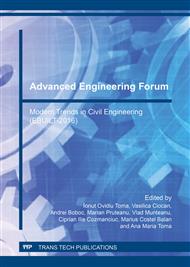[1]
L. Binda, A. Saisi, State of the art of research on historic structures in Italy, 2015, http: /www. researchgate. net.
Google Scholar
[2]
L. Binda, A. Saissi, Research on historic structures in seismic areas in Italy, Progress in Structural Engineering and Materials, 2005, 7, 71-85, John Wiley &Sons, Ltd.
DOI: 10.1002/pse.194
Google Scholar
[3]
I. Lungu, A. Stanciu, M. Aniculaesi, O.E. Colt, Asupra evaluării stării geotehnice a terenului de fundare de sub fundații de suprafață în vederea reabilitării, Editura Politehnium, 2012. pg. 721-725. Vol. II. 1844-850x.
Google Scholar
[4]
A. De Stefano, Structural identification and health monitoring on the historical architectural heritage, Key engineering Materials, vol. 347, 2007, 37-54, Trans Tech Publications, Switzerland.
DOI: 10.4028/www.scientific.net/kem.347.37
Google Scholar
[5]
M. Solonaru, I. Lungu, M. Budescu, Stress analysis of masonry walls in case of limited excavation for foundation underpinning, Bulletin of the Polytechnic Institute of Iasi, Tomul LXI (LXV), Fasc. 3, (2015).
Google Scholar
[6]
A. Giordano, E. Mele, A. De Luca, Modelling of historical masonry structures: comparison of different approaches through a case study, Engineering Structures, 24, 2002, 1057-1069, Elsevier Ltd.
DOI: 10.1016/s0141-0296(02)00033-0
Google Scholar
[7]
V. Mallardo, R. Malvezzi, E. Milani, G. Milani, Seismic vulnerability of historical masonry buildings: A case study in Ferrara, Engineering Structures, 30, 2008, 2223-2241, Elsevier Ltd.
DOI: 10.1016/j.engstruct.2007.11.006
Google Scholar
[8]
P. Lourenco, Computations on historic masonry structures, Progress in Structural Engineering and Materials, 2002, 4, 301-319, John Wiley &Sons, Ltd.
Google Scholar
[9]
L. Soveja, M. Budescu, I. Gosav, Modelling methods for unreinforced masonry structures, Bulletin of the Polytechnic Institute of Iasi, Tomul LIX (LXIII), Fasc. 6, (2013).
Google Scholar
[10]
P. Roca, M. Cervera, G. Gariup, L. Pela, Structural anaysis of masonry historical constructions. Classical and advanced approaches, Archives of Computational Methods in Engineering 2010, 17, 299-325, © CIMNE, Springer.
DOI: 10.1007/s11831-010-9046-1
Google Scholar
[11]
L. Soveja, PhD Thesis, Evaluarea și reabilitarea structurilor istorice din zidărie, (2015).
Google Scholar
[12]
** ANSYS Manual, ANSYS Inc., (2009).
Google Scholar
[13]
M. Solonaru, PhD Thesis, Creșterea siguranței infrastructurilor construcțiilor, (2016).
Google Scholar


